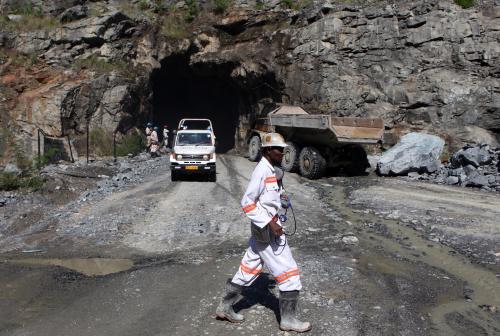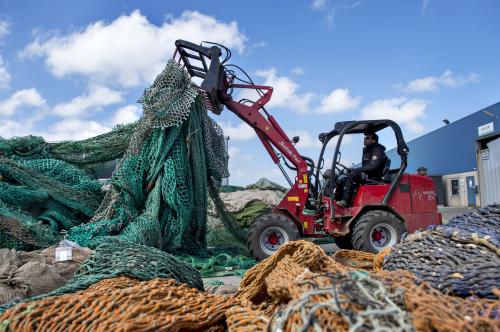This blog is the second in a series of posts surrounding the launch of the new Leveraging Transparency to Reduce Corruption (LTRC) report, “The TAP-Plus Approach to Anti-Corruption in the Natural Resource Value Chain.” You can read the first post in the series here.
Controlling corruption is one of the great global challenges of our time. With as much as $2 trillion lost worldwide to direct corruption every year, it’s no wonder that tackling it is a top priority for governments, international institutions, and civil society.
Any effort at fighting corruption globally must include homing in on an acutely vulnerable sector: extractives. With its enormous cash flows and immense profits, the natural resource value chain is a corruption honey pot. “While corruption can occur almost anywhere, it is most prevalent in a few hot spots. One involves natural resources, especially oil and mining. . . . Indeed, resource-rich countries tend to be more corrupt because they struggle with weaker institutions and poor accountability in the use of their natural wealth,” the IMF’s Paolo Mauro, Paulo Medas, and Jean-Marc Fournier noted last year.
In the last three decades, the fight against corruption has scored some victories, suffered some setbacks, and, above all, has been a learning experience. How do we take these efforts to the next level?
A problem as large and multifaceted as corruption in natural resource governance requires complex, sophisticated analysis. Interventions or measures designed to combat corruption demand a level of situational awareness and analytical insight that match the intricacy of the problem itself.
The Leveraging Transparency to Reduce Corruption project (LTRC), a global initiative launched in 2017 by the Brookings Institution with Results for Development and the Natural Resource Governance Institute (NRGI), proposes a next-generation framework for analyzing natural resource anti-corruption programs. We call this framework “TAP-Plus.”
LTRC builds on decades of research and practice in transparency, accountability, and participation (TAP) and adds to it several factors that we believe create a supercharged anti-corruption toolkit.
Today, bundled TAP interventions (i.e., those that combine two or three elements of TAP) are the pro-integrity tactic most often deployed by reformers to fight corruption, which we generally define as “the abuse of entrusted power for private gain”. In the most basic understanding of TAP, transparency, accountability, and participation work as a triumvirate as part of a positive feedback loop that constrains corruption and incentivizes government action for the common good. But decades of research on the TAP troika have demonstrated that it is not enough.
In our new report, “The TAP-Plus Approach to Anti-Corruption in the Natural Resource Value Chain,” published last week, we lay out the shortcomings of TAP alone—and how to overcome them. We hypothesize that three factors require particular attention in order to achieve scaled-up impact: interventions one, must address the implementation gap within TAP efforts; two, need to consider contextual factors in design of realistic TAP programs; and, three, should consider the inclusion of complementary measures—beyond the traditional TAP field—which interact with TAP interventions and may have a significant impact in preventing or reducing corruption and improving sustainable development outcomes.
Altogether, TAP-Plus provides a new, systematic framework for analyzing corruption and designing interventions. As such, we hope TAP-Plus will serve as a useful resource for practitioners, scholars, and others interested in the development and application of more effective approaches to tackling corruption (particularly along the natural resource value chain) and advancing sustainable development.
This new TAP-Plus approach helps to unpack many of the truisms we often hear in anti-corruption work. Consider the “implementation gap.” It is not surprising to learn that many programs are launched and many laws are passed that then fail to be fully implemented. However, we propose a more rigorous analysis of the implementation gap. We build upon work by NRGI (including its Resource Governance Index), the Open Government Partnership, and on-the-ground practitioners in freedom of information like the World Resources Institute’s Strengthening the Right to Information for People and the Environment (STRIPE) and Environmental Democracy projects. Each have created metrics for either measuring implementation gaps or systematically determining why they are occurring.
To give one example of this analysis, in 2017, NRGI measured the gap between multiple laws on the books versus actual practice in its Resource Governance Index. In one particularly acute instance of the implementation gap, it examined requirements pertaining to national governments that distribute natural resource revenue to subnational governments. All told, 23 of the 33 governments that make those distributions also mandate audits to better ensure transparency and accountability for the transmission of the money. NRGI discovered, however, that, “Audits actually only took place in 12 [of the 23]…” This was one of many implementation gap metrics NRGI used in its index and that LTRC aims to build from.
Or consider the oft repeated axiom “context matters.” Many early TAP efforts suffered from top-down approaches and were part of the “Common swirl of politically related ‘good things,’” rather than being well tailored to on-the-ground, complex environments. Now, it seems self-evident that any TAP initiative to combat corruption (or to improve development outcomes) should be both aware of and adapted to the political economy of its target—if it wants to succeed, at least. But “context” is not always clearly defined.
Based on our literature review of more than 650 works on TAP and the natural resource value chain, we aim to make the sometimes murky idea of “context” more concrete. As a result of our review, we surfaced a set of five specific contextual factors that are conceptually intertwined with TAP. Critically, they also can be examined using well-developed or emerging studies. They are capture; social trust, political trust, and conflict; civic space and media freedom; rule of law; and government effectiveness and capacity. The chart below provides our working definitions of those five contextual factors.
| Contextual Factor | LTRC Working Definition |
| Capture |
“The efforts of firms to shape and influence the underlying rules of the game (i.e., legislation, laws, rules, and decrees) through private payments to public officials” (Hellman et al. 1999, 4).
|
| Social Trust, Political Trust, and Conflict |
Social Trust: The degree to which individuals in a society share and believe others share mutually beneficial goals, regardless of ethnic, racial, or religious categories (Rothstein and Uslaner 2005; Rothstein 2011, 2013).
Political Trust: “[T]rust between citizens and political elites, or citizen confidence in political institutions” (Newton 2005).
Conflict: Contexts of ongoing war or history of war, confrontations between communities and companies, or the presence of armed insurgencies.
|
| Civic Space and Media Freedom |
The basic democratic rights of citizens and journalists to freely associate, assemble, share information, and express opinions without fear of reprisal or censorship.
|
| Rule of Law |
The presence of an institutionalized, understood, trusted, shared, and enforced system of rights and rules that applies to everyone equally; protects all members of a society from harm; provides means of redress, resolution, and relief when harmed; and fairly determines and metes out punishment for those who break laws or violate rights.
|
| Government Effectiveness and Capacity |
The financial and/or technical capacity to carry out the functions necessary to properly manage natural resources and support anti-corruption efforts.
|
TAP-Plus proposes that these five contextual factors must be explicitly considered, measured (where possible), and assessed vis-à-vis specific TAP interventions or governance efforts. Ideally, of course, every TAP intervention or anti-corruption effort would take place in enabling environments where all contextual factors are aligned to support success. But that is not the world we live in. Instead, a clear-eyed understanding of contextual factors allows governance initiatives to adapt where necessary or to alter context where possible.
Finally, TAP-Plus places emphasis on several complementary, natural resource-specific, non-governmental institutions or programs that have an outsized impact on corruption pathways. These can include state-owned enterprises, sovereign wealth funds, and beneficial ownership disclosure schemes. Depending on the jurisdiction in question, these entities and their reform can be highly complementary to the environment that either enables or constrains an anti-corruption intervention.
Our TAP-Plus approach encompasses a complex set of interrelated factors, and we are unlikely to be able to investigate exhaustively each element. But our new report is a first step toward making the analysis of anti-corruption efforts as rich and sophisticated as the problem itself.
Thanks to Robin Lewis for research and editorial assistance, and to Carter Squires for fact-checking and copyediting assistance.






Commentary
Supercharging anti-corruption initiatives: The TAP-Plus approach
July 7, 2020